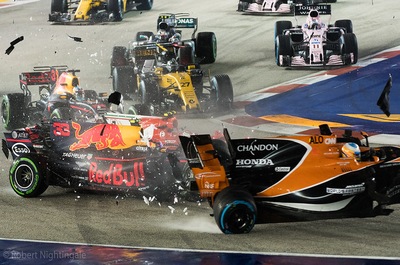
Formula 1 drivers are among some of the best and most alert people you could ever have behind the wheel of a car, but this does not mean accidents do not happen.
Sure, Lewis Hamilton is probably not going to crash into his garage door while parking, but when driving at break-neck speeds, it is very easy for even the best to get it wrong on occasion.
These split-second misjudgements can see cars crash into part of the circuit or collide with other vehicles.
Due to the fragility of Formula 1 cars, anything that can be considered a crash usually puts an immediate end to any driver’s race.
But exactly how often are drivers crashing out of races? Is it a ‘once every few months’ type of incident or can you expect to see pieces flying off cars almost every Grand Prix?
This is exactly what we wanted to find out and we are more than happy to share our findings with you.
Rule Changes Can Impact Crash Rate
Anyone who watches Formula 1 could tell you that it is a sport that contains seemingly constantly changing rules. Big or small, there always seems to be something that F1 bosses want to adjust whether it relates to driver safety, spectator enjoyment or something more administrative. All these changes mean that the further back in time you get, the less relevance it has to present-day Formula 1. Additionally, you have to remember that many tracks used today are quite new to the F1 calendar and different circuits pose different levels of crash risk.
Due to these factors, we are going to focus on looking at recent data to answer the question about how often F1 cars crash as this will give us the best representation of the present situation.
Driver Not Always To Blame
Before we get going, we wanted to stress that a driver who is forced to retire due to a crash is not always to blame. Sometimes they can be minding their own business on the racing line when another car makes contact with them. It is often just a lottery at this point which car, if either, remains largely unscathed and which suffers race-ending damage. That said, if there are drivers who seem to be involved in collisions or accidents on a regular basis, you are probably right to assume it is more than just bad luck.
Crashes In The 2020 Season
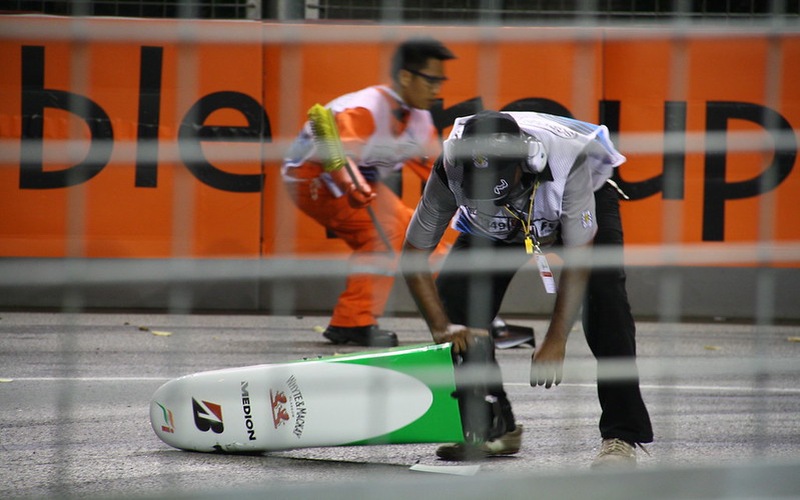
The 2020 Formula 1 season saw 17 races (reduced due to the global health crisis) with almost all races having the full set of 20 drivers competing. The two exceptions were the British Grand Prix and the Belgian Grand Prix as Nico Hulkenburg and Carlos Sainz Jr respectively did not start those races. This means in total there we could have seen 338 drivers crash throughout the course of the year. The actual crash rate, of course, was nowhere near this as F1 drivers generally do all they can to avoid damaging their vehicles. In the table below you can find all instances of a driver colliding with another car or part of the circuit.
| Grand Prix | Drivers Involved in Crash | Number of Drivers Crashed |
|---|---|---|
| Styrian | Charles Leclerc, Sebastian Vettel | 2 |
| British | Daniil Kvyat, Kevin Magnussen | 2 |
| Belgian | Antonio Giovinazzi, George Russell | 2 |
| Italian | Charles Leclerc | 2 |
| Tuscan | Lance Stroll, Nicholas Latifi, Kevin Magnussen, Antonio Giovinazzi, Carlos Sainz Jr., Max Verstappen, Pierre Gasly | 7 |
| Russian | Carlos Sainz Jr., Lance Stroll | 2 |
| Eifel | George Russell | 1 |
| Portuguese | Lance Stroll | 1 |
| Emilia Romagna | George Russell | 1 |
| Turkish | Romain Grosjean, Nicholas Latifi | 2 |
| Bahrain | Lance Stroll, Romain Grosjean | 2 |
| Sakhir | Max Verstappen, Charles Leclerc | 2 |
The total number of crash incidents from the 2020 season was 26, giving us a crash rate of 7.7%. One interesting takeaway from these results is that most incidents were largely in isolation, so involving one or at most two drivers. There was only one exception to this: the Tuscan Grand Prix, in which four cars were involved in a mini-pile up following the departure of the safety car. Much finger-pointing was involved with no driver willing to take responsibility for the incident.
Another interesting takeaway from the 2020 season is that no driver was involved in more than three crashes. What you will notice though is that the worst-performing drivers are more heavily involved in the incidents than the best performing drivers. To a small extent, this makes sense as you are extremely unlikely to collect any points if crashing out of races regularly, but it is not as though these drivers were failing to finish the majority of their races.
Verstappen, Sainz Jr, Leclerc and Gasly were the only drivers to crash that finished in the top half of the drivers’ championship standings. Between them, they accounted for nine of the 26 crashed cars. This means that the bottom 10 drivers were responsible for the remaining 17, making them nearly twice as likely to crash. Do we see similar figures for the 2019 season?
Crashes In The 2019 Season
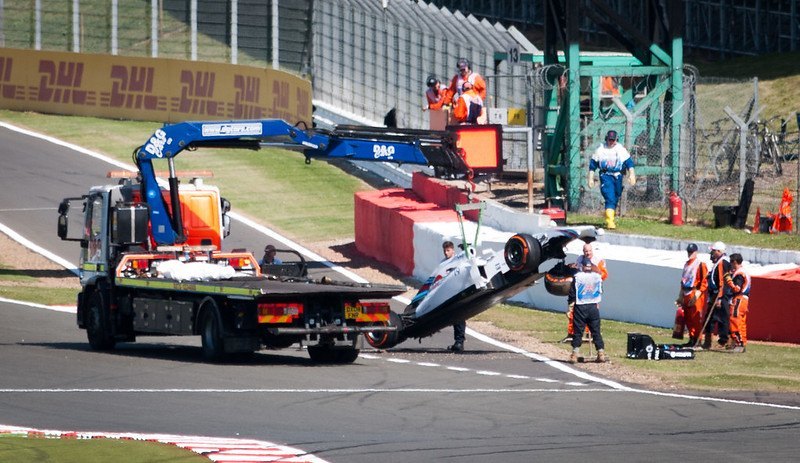
There were more races in the 2019 season, 21 to be precise, with a full cohort of 20 drivers featuring in each. So, the total number of possible crashes for this year stood at 420.
| Grand Prix | Drivers Involved in Crash | Number of Drivers Crashed |
|---|---|---|
| Australian | Daniel Ricciardo | 1 |
| Bahrain | Roman Grosjean | 1 |
| Chinese | Lando Norris, Daniil Kvyat | 2 |
| Azerbaijan | Daniil Kvyat, Daniel Ricciardo | 2 |
| Spanish | Lance Stroll, Lando Norris | 2 |
| Monaco | Charles Leclerc | 1 |
| Canadian | Alexander Albon | 1 |
| British | Romain Grosjean, Kevin Magnussen | 2 |
| German | Pierre Gasly, Valtteri Bottas, Nico Hulkenberg, Charles Leclerc, Sergio Perez | 5 |
| Belgian | Antonio Giovinazzi, Max Verstappen | 2 |
| Singapore | Kimi Raikkonen, George Russell | 2 |
| Russian | George Russell, Daniel Ricciardo, Romain Grosjean | 3 |
| Japanese | Max Verstappen | 1 |
| Brazilian | Sebastian Vettel, Charles Leclerc | 2 |
There were more races featuring a crash in 2019 compared to 2020 but both seasons share a lot of similarities. First of all, there was a real lack of incidents involving several cars. In fact, there was none at all as in the German GP, all accidents happened at different points in the race. By looking across both years, we can also begin to see who the repeat offenders are. Charles Leclerc, Romain Grosjean and George Russell top the list with at least five crashes each.
Overall, our crash rate for this year works at out 6.4% so quite close to the 2020 number. Slower drivers were not much more involved this time though, only accounting for a shade over half (14) of the 27 incidents. Impressively, Lewis Hamilton once again avoided being involved in any crash for the second year running, a real testament to his skill levels and concentration. Though it could be partly explained by the number of races he started at the front of the grid (15 poles over the course of the 2019 and 2020 seasons) and hence away from potential trouble during the start of the races.
Crashes In The 2018 Season
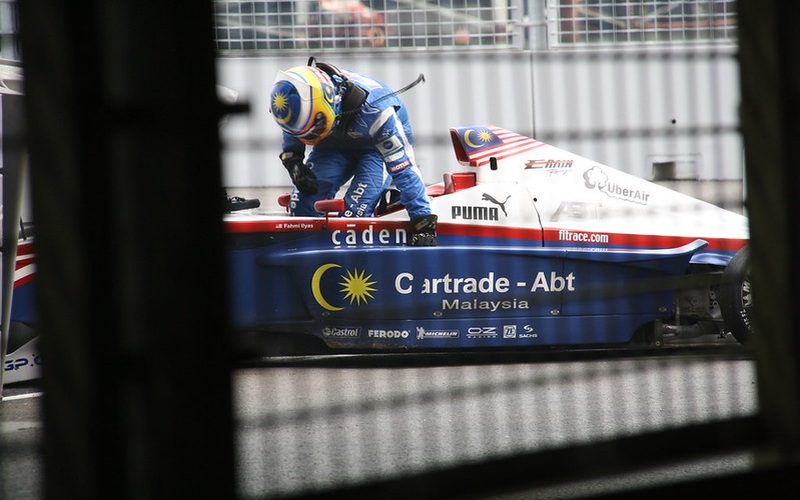
As with 2019, there were 21 races with 20 drivers per race, producing a combined total of 420 rides. There were three disqualifications but as all drivers completed the race before being disqualified, they still had the possibility of crashing, but none did.
| Grand Prix | Drivers Involved in Crash | Number of Drivers Crashed |
|---|---|---|
| Azerbaijan | Romain Grosjean, Max Verstappen, Daniel Ricciardo, Nico Hulkenberg, Esteban Ocon, Sergey Sirotkin | 6 |
| Spanish | Romain Grosjean, Pierre Gasly, Nico Hulkenberg | 3 |
| Monaco | Charles Leclerc, Brendon Hartley | 2 |
| Canadian | Brendon Hartley, Lance Stroll | 2 |
| French | Esteban Ocon, Pierre Gasly | 2 |
| Austrian | Stoffel Vandoorne | 1 |
| British | Romain Grosjean, Carlos Sainz Jr., Marcus Ericsson | 3 |
| German | Sebastian Vettel | 1 |
| Belgian | Daniel Ricciardo, Kimi Raikkonen, Charles Leclerc, Fernando Alonso, Nico Hulkenburg | 5 |
| Italian | Brendon Hartley | 1 |
| Singapore | Esteban Ocon | 1 |
| Japanese | Kevin Magnussen | 1 |
| United States | Charles Leclerc, Romain Grosjean, Fernando Alonso | 3 |
| Brazilian | Marcus Ericsson | 1 |
| Abu Dhabi | Nico Hulkenberg | 1 |
A total of 31 crashes here gives us a crash rate a little higher than 2019, but not a significant amount, 7.4% to be exact. As has been the case for the previous two seasons looked at, crashes more often involved the worst-performing drivers. Looking at those who finished in the bottom half of the drivers’ standings at the end of the year, these were responsible for 22 of the 33 incidents, so 67%.
Conclusion
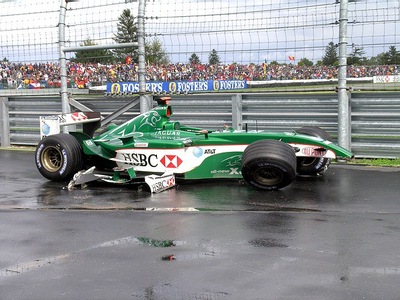
Across the three seasons examined, the average crash rate of drivers was 7.2%. and there was an average of 1.4 crashes per race. Most races stick close to this figure but there are usually one or two races a season that see several cars forced to retire due to a collision or accident. The data also shows that the worst-performing drivers are more likely to be involved in a crash, while it is quite uncommon for the absolute top drivers. Lewis Hamilton for instance did not suffer a single crash in the three-year period examined so clearly, he has a real knack for staying out of danger, or indeed just getting out ahead of the danger.
Although crashes can occur at virtually any time, on any course, there are some are inherently more dangerous than others. In the reduced 2020 season, there were several one-off tracks used so for a better overview, we also looked at track data for the 2017 and 2016 campaigns. This revealed that Monaco is one of the most crash-prone tracks with the full set of drivers never making it to the finish line between 2016 and 2019 (with no race in 2020). Across the four-year period, the Monaco GP averaged 3.75 crashes a time, much higher than the 1.4 average.
Other destinations with higher than average crash rates include Brazil with an average of 3 incidents per race and the Belgian GP which was not too far off with 2.6 crashes per race on average. This counters the assumption that street circuits are far more likely to see accidents, although when accidents do occur on street circuits, they are more likely to involve numerous cars.
The other element worth considering is the weather as we would expect more crashes to occur during a wet race due to the reduced visibility and grip. Clearly conditions make a difference, as they do in driving on the roads, but F1 drivers can often drive to the conditions in ways that the general public sometimes don’t. As such, there is not a huge increase in crashes in wet conditions, though further research (that includes differentiating between partially wet and fully wet races) could shed more light on the exact figures.
